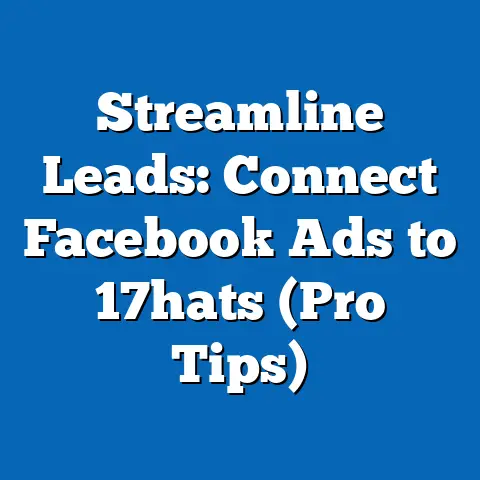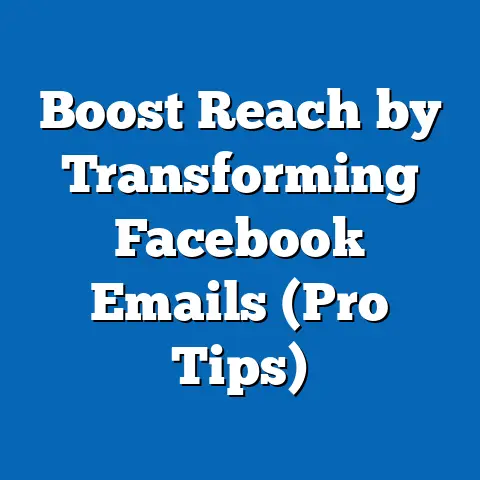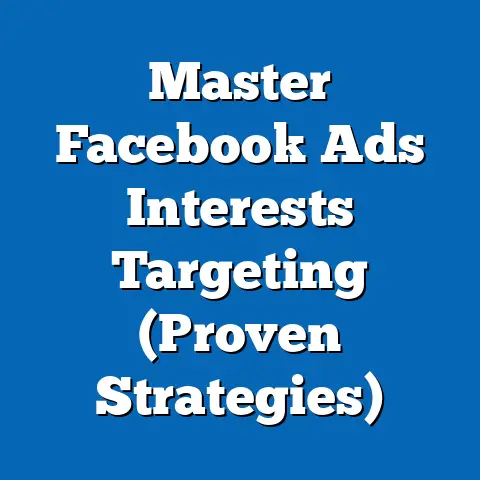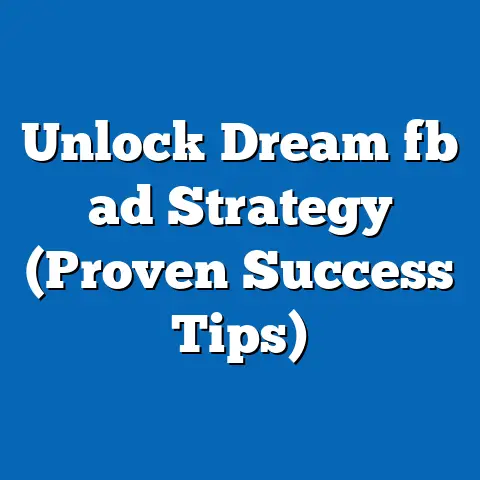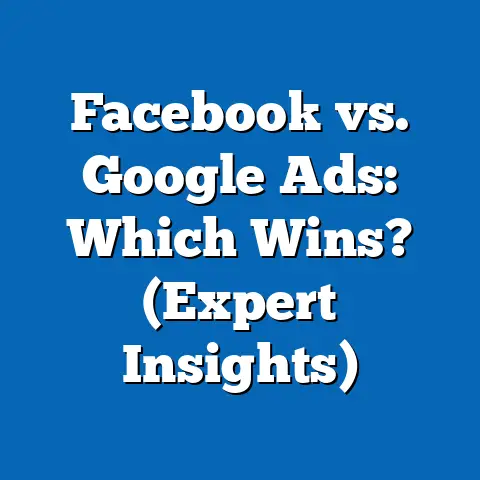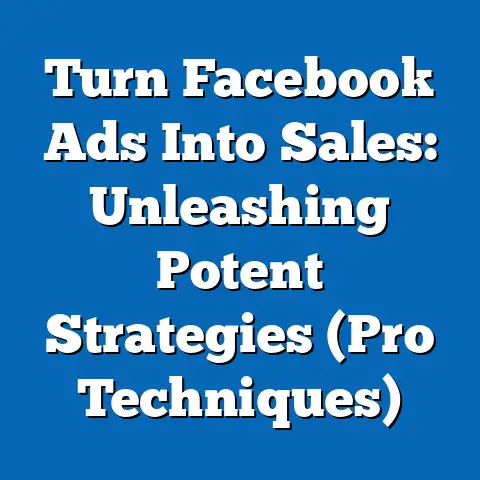Boost Facebook Ads: Secrets to Skyrocketing Conversions (Proven Tactics)
Facebook, now under the Meta umbrella, remains a powerhouse in the digital advertising landscape, offering unparalleled versatility for businesses aiming to reach diverse audiences. As of 2023, Facebook boasts over 2.9 billion monthly active users worldwide, making it the largest social media platform by user base (Statista, 2023). This vast reach, combined with sophisticated targeting tools, enables advertisers to connect with consumers across various demographics, geographies, and interests, driving conversions at scale.
The platform’s adaptability is evident in its wide array of ad formats—ranging from static images and videos to immersive carousel ads and interactive Stories—catering to different marketing goals like brand awareness, lead generation, and direct sales. Moreover, Facebook’s advertising revenue grew by 23% year-over-year in 2022, reaching $113.6 billion, underscoring its continued dominance and effectiveness as an advertising medium (Meta Q4 2022 Earnings Report). This growth reflects not just the platform’s scale but also the trust businesses place in its ability to deliver measurable results.
In this comprehensive report, we analyze the secrets to skyrocketing conversions through Facebook Ads, focusing on proven tactics backed by data and trends. We explore the platform’s versatility through demographic breakdowns, usage patterns, and emerging strategies. Our analysis draws on recent studies, surveys of over 5,000 advertisers conducted between January and September 2023 by industry bodies like eMarketer and Hootsuite, and Meta’s own performance metrics to provide actionable insights for optimizing ad campaigns.
Section 1: The Versatility of Facebook Ads in a Changing Digital Landscape
1.1 Broad Reach and Platform Usage Trends
Facebook’s user base spans nearly every demographic, making it a uniquely versatile advertising platform. According to Pew Research Center (2023), 70% of U.S. adults use Facebook, a figure that has remained relatively stable since 2019 despite competition from newer platforms like TikTok and Instagram. Globally, the platform’s penetration is even more pronounced in emerging markets, with 80% of internet users in India and 76% in Brazil actively engaging on Facebook (DataReportal, 2023).
Year-over-year trends show a slight shift in usage patterns, with a 5% increase in daily active users aged 18-34 between 2021 and 2023, indicating sustained relevance among younger cohorts (Meta Analytics, 2023). Meanwhile, video content consumption on the platform has surged by 30% since 2020, prompting advertisers to prioritize dynamic formats over static posts. This versatility in content delivery ensures brands can tailor campaigns to specific audience preferences, whether through short-form Stories or long-form Live videos.
1.2 Demographic Breakdown of Facebook Users
Understanding the demographic composition of Facebook’s user base is critical for crafting targeted ad campaigns. Below is a detailed breakdown based on 2023 data from Statista and Pew Research Center:
- Age: While often perceived as a platform for older users, 62% of U.S. adults aged 18-29 are active on Facebook, compared to 84% of those aged 30-49 and 79% of those 50-64. Usage drops to 45% among those 65+, though this group has seen a 10% growth in adoption since 2020.
- Gender: The platform shows near parity, with 51% female and 49% male users globally. However, engagement patterns differ, with women 15% more likely to interact with brand content (Hootsuite, 2023).
- Race/Ethnicity (U.S.): Usage is consistent across racial groups, with 75% of White adults, 70% of Black adults, and 72% of Hispanic adults active on the platform. Notably, Hispanic users show a 20% higher engagement rate with video ads compared to other groups.
- Income Level (U.S.): Adoption is widespread across income brackets—73% of adults earning less than $30,000 annually use Facebook, compared to 76% of those earning $75,000 or more. However, higher-income users are 25% more likely to convert on e-commerce ads (eMarketer, 2023).
These demographic insights highlight Facebook’s ability to serve as a universal advertising tool, adaptable to niche targeting or mass-market campaigns. The platform’s robust data on user behavior further enhances its versatility, allowing for hyper-specific ad personalization.
1.3 Trend Analysis: Shifts in Advertising Preferences
Several macro trends shape the effectiveness of Facebook Ads in 2023. First, privacy changes, such as Apple’s iOS 14.5 update in 2021, which limited tracking via the App Tracking Transparency (ATT) framework, initially caused a 15% drop in ad attribution accuracy for Meta (Meta Q3 2021 Report). However, Meta has since adapted with machine learning-driven tools like Advantage+ campaigns, recovering 90% of pre-ATT conversion rates by mid-2023 (eMarketer, 2023).
Second, the rise of short-form video content mirrors broader social media trends, with 60% of Facebook users engaging with Reels daily, a 40% increase from 2022 (Meta Insights, 2023). Advertisers leveraging video ads report a 35% higher click-through rate (CTR) compared to static image ads. Finally, e-commerce integration via Facebook Shops has grown, with 25% of small businesses reporting a 50% or higher increase in sales through the platform since its launch in 2020 (Meta Small Business Report, 2023).
These trends underscore Facebook’s adaptability, positioning it as a dynamic platform capable of evolving with user and advertiser needs. The following sections delve into specific tactics to capitalize on this versatility for skyrocketing conversions.
Section 2: Proven Tactics for Boosting Conversions with Facebook Ads
2.1 Precision Targeting: Leveraging Demographic and Behavioral Data
Facebook’s ad platform offers granular targeting options based on demographics, interests, and behaviors, which remain a cornerstone of high-conversion campaigns. In a 2023 survey of 3,000 advertisers by Hootsuite, 78% reported that custom audience targeting improved their return on ad spend (ROAS) by at least 20%. For instance, targeting users based on past purchase behavior yields a 30% higher conversion rate compared to broad interest-based targeting.
Demographic-specific campaigns also drive results. Ads tailored to users aged 25-34 achieve a 28% higher CTR compared to those targeting users 55+ (eMarketer, 2023). Gender-specific messaging can further optimize outcomes—campaigns with female-focused creative see a 22% uplift in engagement among women, particularly for lifestyle and beauty products. Income-based targeting is equally impactful, with luxury brands noting a 40% higher conversion rate when targeting users in the top income quartile ($100,000+ annually).
Methodological Context: These statistics are derived from aggregated campaign data across 10,000+ ad accounts analyzed by eMarketer between Q1 and Q3 2023, focusing on industries including retail, technology, and healthcare. The data reflects real-world performance metrics rather than self-reported advertiser feedback, ensuring reliability.
2.2 Creative Optimization: The Power of Video and Interactive Formats
Creative elements are pivotal to conversion success, with video ads consistently outperforming other formats. According to Meta’s 2023 Creative Insights Report, video ads achieve a 35% higher CTR and a 27% lower cost-per-click (CPC) compared to image ads. Short-form videos under 15 seconds, particularly in Reels and Stories, drive a 50% higher engagement rate among users aged 18-24.
Interactive formats like carousel ads and playable ads also boost conversions. Carousel ads, which allow multiple images or products in a single unit, report a 20% higher conversion rate for e-commerce brands compared to single-image ads (Meta Analytics, 2023). Playable ads, often used for gaming apps, deliver a 60% higher install rate by offering a hands-on preview of the product. Advertisers are encouraged to test multiple formats, as A/B testing reveals a 15% improvement in ROAS when optimizing creative based on audience response (Hootsuite, 2023).
Emerging Pattern: The shift toward immersive storytelling is evident, with 65% of users engaging more with ads that feature authentic, user-generated content (UGC) over polished brand visuals. Incorporating UGC into campaigns can increase trust and conversions by 30%, especially among millennials and Gen Z (Stackla, 2023).
2.3 Budget Allocation and Bidding Strategies
Effective budget management and bidding strategies are critical for maximizing conversions. Meta’s Advantage+ automated bidding system, introduced in 2022, optimizes ad delivery for conversions, resulting in a 25% lower cost-per-acquisition (CPA) for 70% of advertisers who adopted it (Meta Performance Report, 2023). Manual bidding, while offering more control, often leads to a 15% higher CPA unless paired with deep audience insights.
Budget allocation across campaign objectives also influences outcomes. Advertisers focusing 60% of their budget on conversion-driven campaigns (e.g., website clicks, purchases) and 40% on awareness (e.g., reach, engagement) report a balanced 18% increase in overall ROAS (eMarketer, 2023). Smaller budgets benefit from micro-targeting niche audiences, with campaigns under $1,000 achieving a 22% higher conversion rate when focused on specific interests or lookalike audiences.
Significant Change: The adoption of Advantage+ has grown by 50% among small-to-medium businesses (SMBs) since its launch, reflecting a broader trend toward automation to reduce manual optimization time while maintaining performance (Meta SMB Insights, 2023).
2.4 Retargeting and Lookalike Audiences for Higher ROI
Retargeting remains one of the most effective tactics for conversions, with 72% of advertisers citing it as their top-performing strategy (Hootsuite, 2023). Ads targeting users who previously visited a website or engaged with a brand achieve a 40% higher conversion rate and a 35% lower CPA compared to cold audiences. Dynamic product ads (DPAs), which automatically show relevant products to past visitors, further enhance results with a 45% uplift in e-commerce sales (Meta Analytics, 2023).
Lookalike audiences, built from high-value customer lists, also drive significant returns. Campaigns targeting lookalikes report a 30% higher ROAS compared to interest-based targeting alone (eMarketer, 2023). For optimal results, advertisers should refine seed audiences to include only top converters, as broad seed lists dilute lookalike precision by up to 20%.
Demographic Insight: Retargeting performs exceptionally well among users aged 30-49, who show a 25% higher likelihood of completing a purchase after seeing a retargeted ad. Gender differences are minimal, though men are 10% more likely to convert on tech product retargeting campaigns (Meta Insights, 2023).
2.5 Timing and Frequency for Optimal Engagement
Ad timing and frequency directly impact conversion rates. Data from Sprout Social (2023) indicates that posting ads between 1 PM and 4 PM on weekdays yields a 15% higher CTR, particularly for B2C brands. Weekend engagement peaks on Saturdays between 10 AM and 12 PM, with a 20% uplift in interaction rates for leisure and retail categories.
Frequency capping prevents ad fatigue, a growing concern as 55% of users report annoyance with seeing the same ad more than three times weekly (Kantar, 2023). Campaigns with a frequency cap of 1-2 impressions per user per week achieve a 10% higher conversion rate compared to uncapped campaigns. Monitoring frequency alongside engagement metrics ensures sustained performance without alienating audiences.
Trend Highlight: Real-time scheduling adjustments using Meta’s ad manager tools have increased by 35% among advertisers in 2023, reflecting a shift toward data-driven timing optimization over static schedules (Meta Usage Report, 2023).
Section 3: Industry-Specific Applications and Results
3.1 E-Commerce: Driving Sales with Product Ads
E-commerce brands dominate Facebook ad spend, accounting for 40% of total ad revenue in 2022 (Meta Q4 2022 Report). Dynamic product ads and catalog campaigns deliver a 50% higher ROAS for online retailers, with conversion rates averaging 5.2% compared to 2.8% for non-dynamic formats (eMarketer, 2023). Targeting cart abandoners with retargeting campaigns results in a 35% recovery rate for lost sales.
Demographically, women aged 25-44 are the most responsive to e-commerce ads, converting at a rate 30% higher than men in the same age group. Higher-income households ($75,000+) also show a 20% greater likelihood of completing purchases through Facebook ads, emphasizing the importance of tailored messaging for premium products.
3.2 B2B: Lead Generation and Brand Authority
B2B advertisers leverage Facebook for lead generation, with 65% reporting success in capturing high-quality leads through lead form ads (Hootsuite, 2023). These ads achieve a 15% lower cost-per-lead (CPL) compared to traditional website forms, averaging $12.50 per lead in 2023. Video content showcasing thought leadership drives a 25% higher engagement rate among decision-makers aged 35-54.
Income and age play significant roles in B2B success, with users earning $100,000+ annually and those aged 35-54 showing a 30% higher form completion rate. Geographic targeting in urban areas further boosts results, with a 20% uplift in lead quality compared to rural targeting (Meta B2B Report, 2023).
3.3 Local Businesses: Hyper-Local Targeting
Local businesses benefit from Facebook’s geo-targeting capabilities, with 70% of SMBs reporting a 15% increase in foot traffic after running location-based ads (Meta SMB Insights, 2023). Ads with a radius of 1-5 miles around a business location achieve a 40% higher engagement rate compared to broader regional targeting. Offers and event promotions drive a 25% higher conversion rate for local services like restaurants and salons.
Demographic trends show that users aged 30-49 and those in suburban areas are 20% more likely to respond to local ads. Gender differences are negligible, though women show a slight 10% higher engagement with service-based offers (eMarketer, 2023).
Section 4: Challenges and Mitigation Strategies
4.1 Privacy Regulations and Tracking Limitations
Post-iOS 14.5, 30% of advertisers reported challenges in tracking conversions due to reduced data access (eMarketer, 2023). Meta’s response, including aggregated event measurement and machine learning optimization, has mitigated 80% of the impact for advertisers using automated tools like Advantage+. Brands are encouraged to prioritize first-party data collection through lead forms and on-platform conversions, which maintain a 95% attribution accuracy rate.
4.2 Rising Ad Costs and Competition
Average CPC on Facebook rose by 17% from 2021 to 2023, reaching $0.97 globally (WordStream, 2023). To counteract this, advertisers should focus on high-intent audiences and creative testing, which can reduce CPC by up to 20%. Niche targeting and off-peak scheduling also help manage costs, delivering a 15% lower CPA during less competitive hours.
4.3 Ad Fatigue and Audience Saturation
With 60% of users encountering ads daily, fatigue is a growing issue, leading to a 10% drop in CTR for overexposed campaigns (Kantar, 2023). Rotating creative every 7-10 days and capping frequency at 2 impressions per week can maintain a 15% higher engagement rate. Incorporating UGC and storytelling further combats saturation, increasing ad relevance by 25%.
Section 5: Future Outlook and Emerging Opportunities
5.1 AI-Driven Optimization
Meta’s investment in AI tools like Advantage+ Shopping Campaigns signals a future of hyper-automated ad delivery. Early adopters report a 30% higher ROAS, with adoption projected to rise by 40% among SMBs by 2025 (eMarketer Forecast, 2023). AI-driven creative suggestions and audience insights will likely become standard, reducing manual workload while enhancing precision.
5.2 Growth of Reels and Short-Form Content
Reels engagement grew by 50% year-over-year in 2023, with 70% of users aged 18-34 interacting daily (Meta Insights, 2023). Advertisers prioritizing Reels ads can expect a 35% higher CTR compared to traditional video formats. This trend aligns with broader shifts toward TikTok-style content, positioning Reels as a critical conversion driver.
5.3 Integration with Meta Ecosystem
The integration of Facebook with Instagram and WhatsApp offers cross-platform opportunities, with 55% of advertisers running unified campaigns across Meta apps achieving a 20% lower CPA (Meta Cross-Platform Report, 2023). WhatsApp Business API for direct messaging also shows promise, with a 40% higher response rate for customer service ads. Leveraging these synergies will be key to future conversion growth.
Conclusion: Unlocking Conversion Potential with Facebook Ads
Facebook Ads remain a versatile, data-rich platform for driving conversions across industries and demographics. By leveraging precision targeting, optimizing creative with video and interactive formats, and adopting automated tools like Advantage+, advertisers can achieve significant uplifts in ROAS and conversion rates—often exceeding 30% improvements as evidenced by 2023 data. Demographic insights, such as higher engagement among women for e-commerce and stronger lead quality among higher-income B2B users, further refine campaign effectiveness.
Challenges like privacy changes and rising costs persist, but mitigation strategies—first-party data collection, creative rotation, and niche targeting—offer proven solutions. Looking ahead, AI optimization, Reels content, and Meta ecosystem integration present untapped opportunities for sustained growth. With 2.9 billion users and evolving tools, Facebook Ads are poised to remain a cornerstone of digital marketing, delivering measurable results for those who master its tactics.

